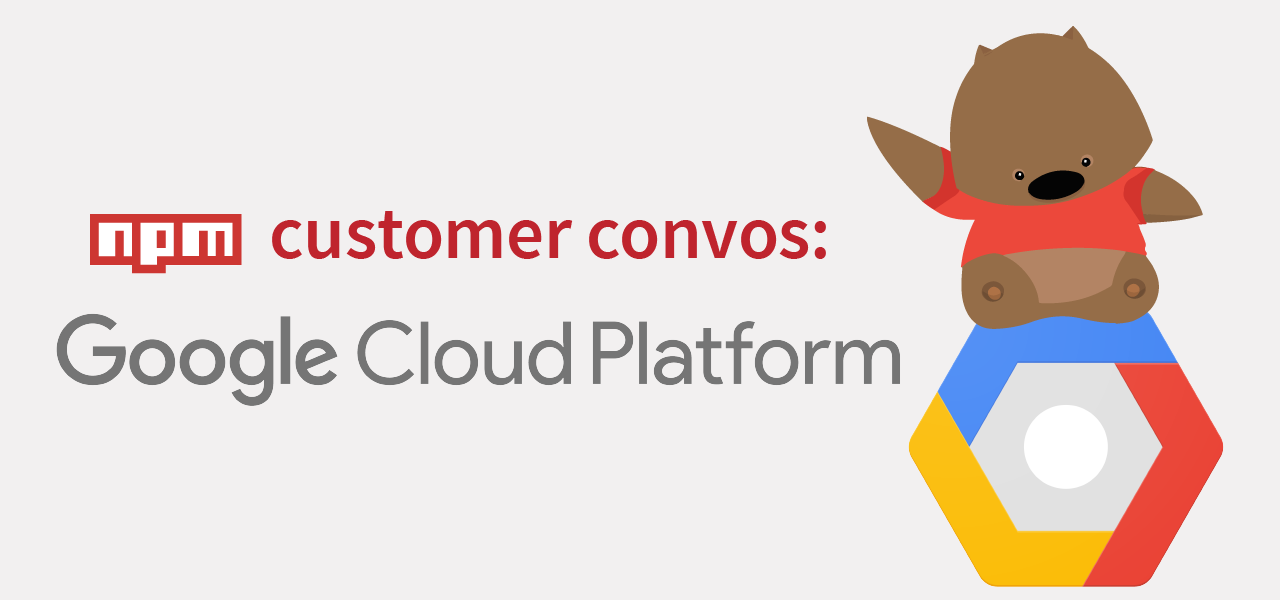The npm blog has been discontinued.
Updates from the npm team are now published on the GitHub Blog and the GitHub Changelog.
Customer Convos: The Google Cloud Team

This piece is a part of our Customer Convos series. We’re sharing stories of how people use npm at work. Want to share your thoughts? Drop us a line.
Q: Hi! Can you state your name and what you do, and what your company does?
Luke Sneeringer, SWE: Our company is Google.
How about this: what specifically are you doing? What does your team do?
LS: I am responsible for the authorship and maintenance of cloud client libraries in Python in Node.js.
Justin Beckwith, Product Manager: Essentially, Google has over 100 APIs and services that we provide to developers, and for each of those APIs and services we have a set of libraries we use to access them. The folks on this team help build the client libraries. Some libraries are automatically generated while others are hand-crafted, but for each API service that Google has, we want to have a corresponding npm module that makes it easy and delightful for Node.js users to use.
How’s your day going?
JB: My day’s going awesome! We’re at a Node conference, the best time of the year. You get to see all your friends and hang out with people that you only get to see here at Node.js Interactive and at Node Summit.
Today, we announced the public beta of Firestore, and of course we published an npm package. Cloud Firestore is a fully-managed NoSQL database, designed to easily store and sync app data at global scale.
Tell me the story of npm at your company. What specific problem did you have that private packages and Orgs solved?
JB: Google is a large company with a lot of products that span a lot of different spaces, but we want to have a single, consistent way for all of our developers to be able to publish their packages. More importantly, we need to have some sort of organizational mesh for the maintenance of those packages. For instance, if Ali publishes a package one day, and then tomorrow he leaves Google, we need to make sure we have the appropriate organization in place so that multiple people have the right access.
Ali Shiekh, SWE: We use npm Organization features to manage our modules and have teams set up to manage each of the distinct libraries that we have.
JB: We’re also users of some of the metrics that y’all produce. We use the number of daily installs for each module to measure adoption of our libraries and to figure out how they’re performing, not only against other npm modules but also other languages we support on the platform.
How do you consume that? Just logging into the website?
JB: No, we do a HTTP call, grab the response, and put it into BigQuery. Then we do analytics over that data in BigQuery and have it visualized on our dashboards.
How can private packages and orgs help you out?
JB: At Google, any time we release a product, there are four release phases that we go through, and the first is what we call an EAP, which is an “Early Access Preview” for a few hundred customers. When we’re distributing those EAPs, it can be difficult to get packages in the hands of customers. We don’t want to disclose a product that’s coming out, because we haven’t announced it yet, but we still need validation and feedback from people that we’ve built the right API and we have the right thing. Moving forward, that’s the way we’d like to use private packages.
What’s an improvement on our side that you would like to see? Or something you would like to see in the future?
LS: Something that we would be interested in seeing npm develop is the ability to have certain versions of a public package be private. Let’s say that we have 1.0, and there’s a 2.0 being developed in private that’s being EAP’ed.… I don’t think you have the concept yet of a private version of a public package.
Along with that, better management of package privacy. Managing an EAP for five people is very different than managing an EAP for 300 people. Another thing that would be nice would be the ability to give another npm Org access to a module at once.
AS: The user interface for Org controls and access management of teams within orgs seems a bit not fully defined at this point. Getting some of that management of Orgs in the UI would be a lot nicer. Before Orgs existed, we had a lot of modules that were published without Orgs, and getting them added to the org is fairly complicated because you have to go through a support ticket to get that done.
JB: Until this morning, you want to know what my first answer would have been?
2FA?
JB: 2FA! Yes.
LS: Also, Fido U2F, please. That is the standard behind security keys.
Would you recommend that another organization use npm Orgs?
JB: Well, yes, and also, it’s a provocative question… is there an alternative?
LS: I was going to say; you’re the only game in town.
Any other cool stuff you’d like to promote?
JB: The Firestore launch, of course, but another thing is the Google Stackdriver Debugger agent. We released this service called Stackdriver Debugger that lets you do passive debugging in production. You push your code to App Engine, or Kubernetes, or Compute engine. While it’s running, you can set breakpoints, and when that code gets hit, it will take a snapshot and visualize that without blocking the request. It’s a passive production debugger.
Did you just ‘one more thing’ us there? ‘Oh also, check out this amazing thing’!
JB: It’s kind of dark magic, actually. It’s a little ridiculous.